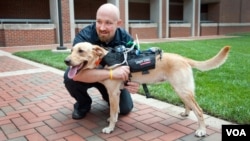Dog-loving scientists at North Carolina State University have figured out a way to communicate better with man's best friend — via tactile means, not verbally.
David Roberts, a mathematician and computer scientist at the Raleigh university, said he and his colleagues have developed a comfortable harness with a small computer mounted on it that allows dog owners to detect, from a distance, what Fido is doing and feeling.
“This involves outfitting the harness with a bunch of sensors that are dedicated to monitoring the environment that the dog is in, as well as monitoring the dog itself," Roberts said, "and then also being able to send input back to the dog via haptics, a gentle vibration much like you would feel when a cellphone goes off in your pocket.”
Smart harness
The harness, which can record a dog’s heartbeat and temperature and measure its activity level, is controlled wirelessly through a cellphone app.
Roberts said the device runs two programs and has a number of potential applications. For instance, it can be used with service dogs that guide sight-impaired people. These dogs, Roberts said, are particularly vulnerable to stress, even though they are trained to remain very calm.
When their work "builds up to a point that it starts to affect their well-being, they have to be retired,” he said.
A handler who can detect a dog’s discomfort can remove the animal from a bad situation, improving its health and quality of life.
The high-tech harness can also be used on search-and-rescue dogs, and on military dogs trained to locate explosives.
Haptic vibrations
When such dogs "catch a whiff of something, they could be out at several hundred yards, working away from the handler. And the handler could get a little beep on a handheld device saying, 'Hey, your dog is on some scents.' "
The beep on a cellphone tells the handler that the dog has laid down in front of a scent, as such animals are trained to do.
The harness can be customized with environmental sensors that detect hazards such as gas leaks, as well as a camera and microphone for collecting additional information.
Haptic vibrations also can send precisely timed signals from the handler to help train a dog.
Roberts and his colleagues are in the process of miniaturizing the computer and improving the physiological sensors so the harness can be used in animal shelters and hospitals.The National Science Foundation is funding their research.








